Mining Company Financial Model
20-Year Financial Model for a Mining Company
This very extensive 20 Year Mining Company Model involves detailed revenue projections, cost structures, capital expenditures, and financing needs from an Iron Ore Mining company. This model provides a thorough understanding of the financial viability, profitability, and cash flow position of the centre. Includes: 20x Income Statements, Cash Flow Statements, Balance Sheets, CAPEX sheets, OPEX Sheets, Statement Summary Sheets, Commodity Price Forecasts, and Revenue Forecasting Charts with the editable revenue streams, BEA charts, sales summary charts, employee salary tabs and expenses sheets. Over 145 Excel spreadsheets and financial charts to monitor.
Income Statement (Profit & Loss Statement)
The Income Statement summarizes revenues, costs, and profitability over a period.
Key Components:
Revenue
Ore Sales Revenue: Quantity (tons) × Price per ton (commodity price)
By-Product Sales (if applicable, e.g., gold as a by-product of copper mining)
Adjustments for Hedging (if the company uses commodity price hedging)
Operating Costs (COGS – Cost of Goods Sold)
Mining Costs: Labor, fuel, explosives, maintenance
Processing Costs: Crushing, milling, refining
Transport & Logistics: Shipping to buyers
Royalties & Taxes: Government royalties (% of revenue)
Depreciation & Amortization: Based on mine life and capital expenditures
Gross Profit
= Total Revenue – COGS
Operating Expenses (OPEX)
General & Administrative (G&A): Salaries, office costs
Exploration Expenses: Drilling, feasibility studies
Sustaining Capital: Minor capex to maintain production
Rehabilitation Costs: Environmental provisions
EBITDA (Earnings Before Interest, Taxes, Depreciation & Amortization)
= Gross Profit – Operating Expenses
EBIT (Earnings Before Interest & Taxes)
= EBITDA – Depreciation & Amortization
Interest Expense
Debt financing costs
Taxes
Corporate Income Tax (e.g., 30% of taxable income)
Mining-Specific Taxes (e.g., resource rent tax)
Net Income (Profit After Tax – PAT)
= EBIT – Interest – Taxes
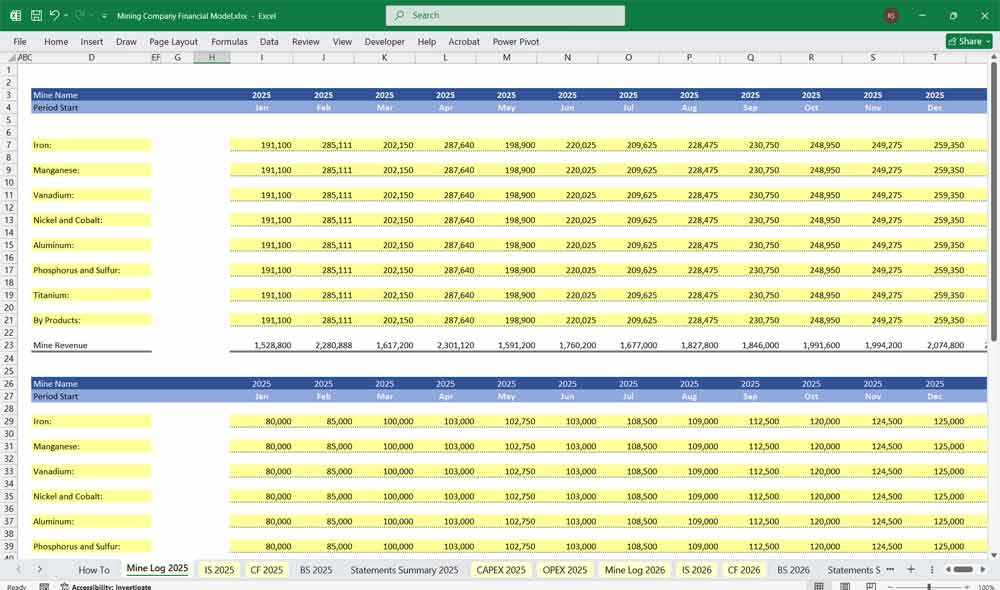
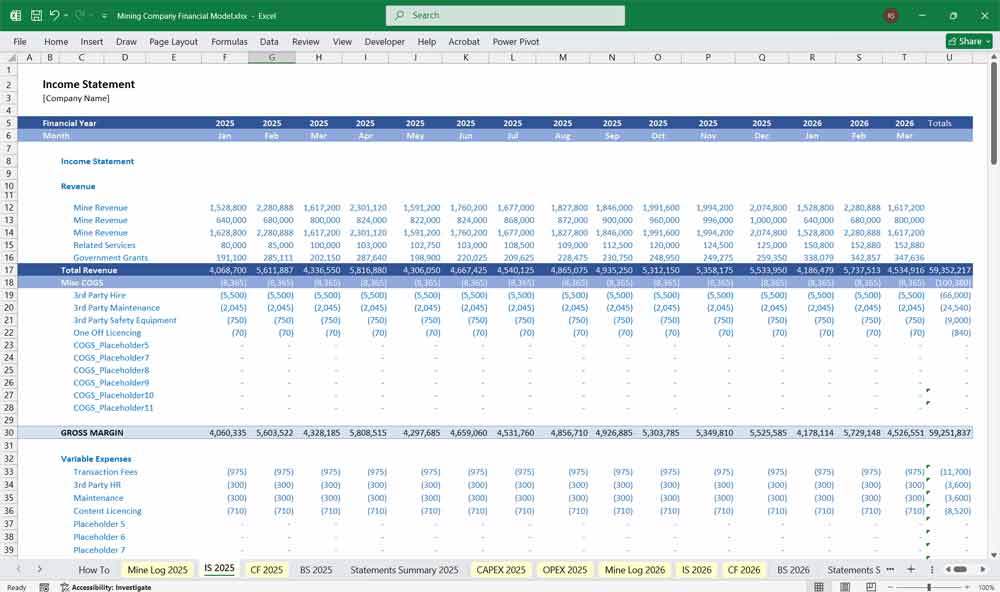
Mining Company Cash Flow Statement
The Cash Flow Statement tracks cash inflows and outflows across three categories:
A. Cash Flow from Operations (CFO)
Net Income (from Income Statement)
Adjustments for Non-Cash Items:
Depreciation & Amortization (added back)
Changes in Working Capital (inventory, receivables, payables)
Taxes Paid (cash outflow)
B. Cash Flow from Investing (CFI)
Capital Expenditures (Capex):
Development Capex: New mine construction, equipment
Sustaining Capex: Maintenance of existing operations
Exploration Expenditures
Proceeds from Asset Sales (if any)
C. Cash Flow from Financing (CFF)
Debt Issuance / Repayment
Equity Issuance (e.g., share offerings)
Dividends Paid (if applicable)
Net Change in Cash
= CFO + CFI + CFF
Ending Cash Balance
= Beginning Cash + Net Change in Cash
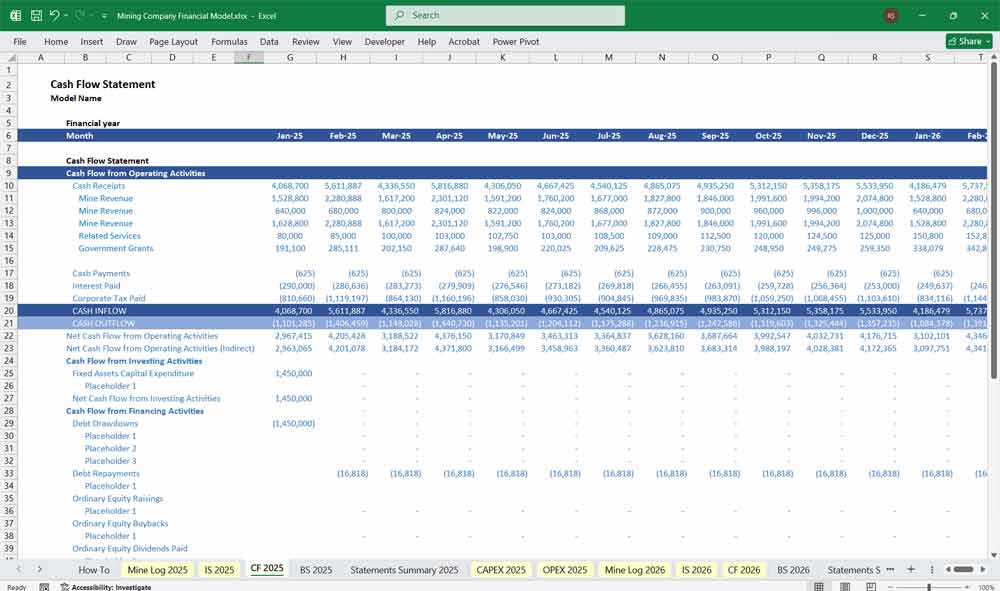
Mining Company Balance Sheet
The Balance Sheet provides a snapshot of the company’s financial position at a point in time.
Assets
Current Assets
Cash & Equivalents (from Cash Flow Statement)
Accounts Receivable (unpaid sales)
Inventory (stockpiled ore, spare parts)
Non-Current Assets
Property, Plant & Equipment (PP&E)
Mine development costs
Heavy machinery, processing plants
Less: Accumulated Depreciation
Mineral Rights & Exploration Assets
Goodwill & Intangibles (if acquired)
Liabilities
Current Liabilities
Accounts Payable (unpaid suppliers)
Short-Term Debt (due within a year)
Current Portion of Long-Term Debt
Non-Current Liabilities
Long-Term Debt (bank loans, bonds)
Deferred Tax Liabilities
Mine Rehabilitation Provisions (future environmental costs)
Shareholders’ Equity
Common Stock (issued shares)
Retained Earnings (accumulated profits)
Additional Paid-In Capital (if shares issued at a premium)
Balance Check
Total Assets = Total Liabilities + Shareholders’ Equity
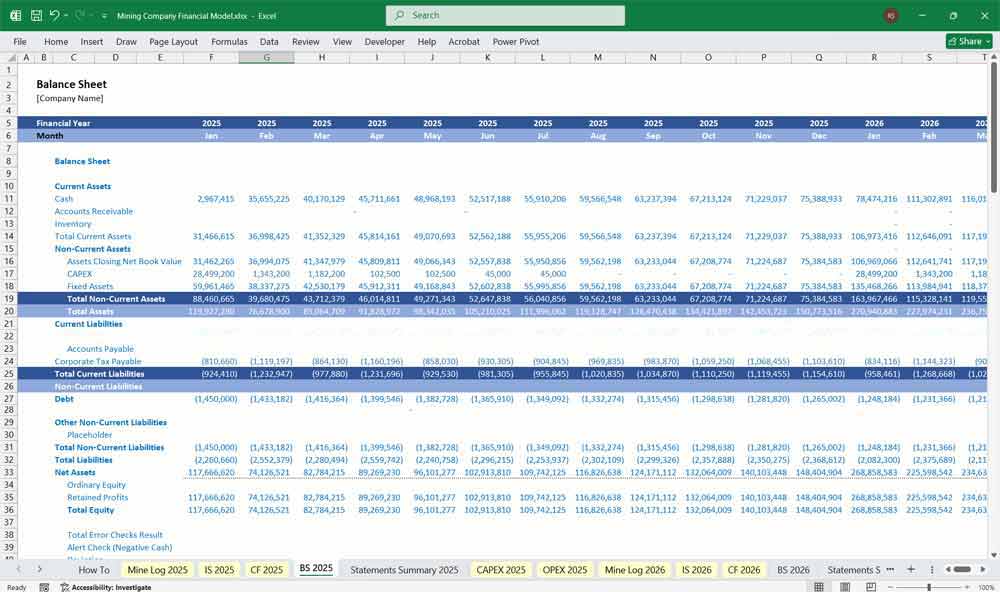
Key Components of The Mining Financial Model
Operational Assumptions: The model starts with operational data, including the amount of ore to be mined and the recovery rate (how much of the mineral is successfully extracted).
Commodity Price Forecast: The model projects future prices for the mined commodity (e.g., gold, copper) based on market research and expert forecasts. A small change in this assumption can drastically alter the model’s output.
Cost Structure: The model breaks down costs into two main categories:
Operating Costs (OPEX): These are the day-to-day costs, often measured per tonne of ore processed or per unit of metal produced (e.g., all-in sustaining costs, or AISC).
Capital Expenditures (CAPEX): These are the large, one-time investments in equipment, mine development, and infrastructure.
Additional Key Mining-Specific Metrics
EBITDA Margin = EBITDA / Revenue
Free Cash Flow (FCF) = CFO – Capex
Net Debt = Total Debt – Cash
Reserves & Resources (tonnage and grade) impact long-term revenue
Payback Period (time to recover initial investment)
Internal Rate of Return (IRR) (project profitability measure)
Benefits Of A 20-Year Financial Model
Long-Term Strategic Planning For Your Mining Company
A 20-year financial model allows a mining company to align its operations with long-term strategic goals. Since mining projects often have lifespans of decades, a multi-decade forecast helps management plan exploration, development, and production phases efficiently. It ensures that capital allocation (e.g., mine expansions, equipment upgrades) is optimized over the entire project lifecycle rather than just the short term.
Improved Mining Company Financing & Investment Decisions
Investors and lenders require visibility into a mining company’s long-term cash flows to assess risk and returns. A 20-year model provides a detailed projection of revenue, costs, and debt repayment capacity, making it easier to secure loans or equity financing. It also helps evaluate the feasibility of large-scale projects by estimating payback periods and IRR over an extended horizon.
Mining Commodity Price & Market Cycle Resilience
Mining is highly cyclical, with commodity prices fluctuating over years or decades. A 20-year model enables scenario analysis—testing how different price assumptions impact profitability. This helps companies prepare for downturns by structuring flexible debt, hedging strategies, and cost controls while maximizing gains during price upswings.
Life-of-Mine (LOM) Optimization
A 20-year financial model integrates Life-of-Mine planning, ensuring that extraction rates, processing capacity, and rehabilitation costs are economically balanced. It helps avoid premature mine closures or underutilized resources by forecasting when additional reserves need to be developed or when cost efficiencies must be implemented.
Ensures Long Term Regulatory & Environmental Compliance For Your Mining Company
Mining projects face long-term environmental and regulatory obligations, such as mine closure costs and carbon taxes. A 20-year model ensures these liabilities are accurately provisioned, avoiding financial shortfalls. It also supports sustainability planning by forecasting the costs of transitioning to cleaner technologies or meeting future ESG (Environmental, Social, and Governance) standards.
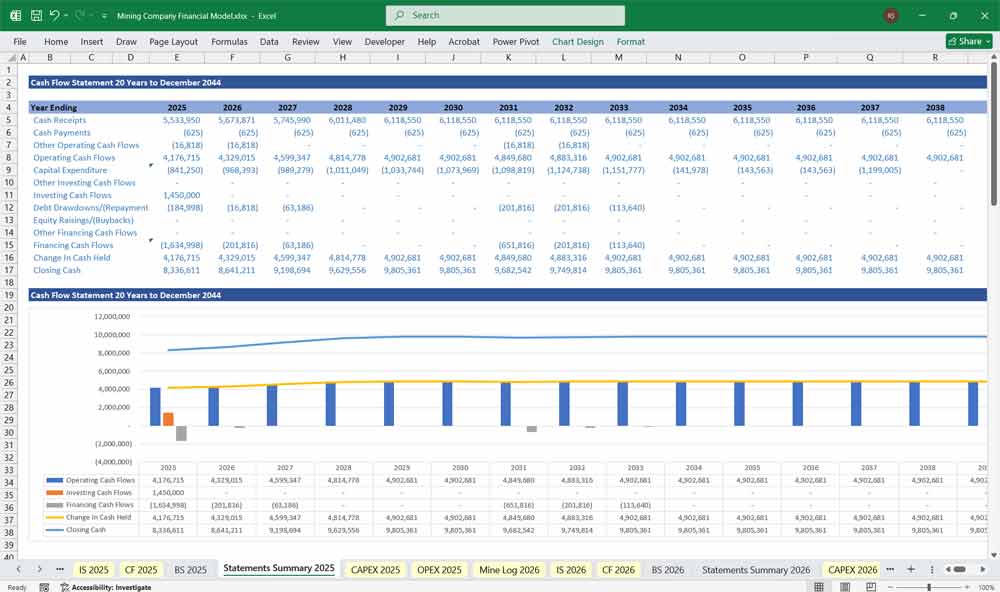
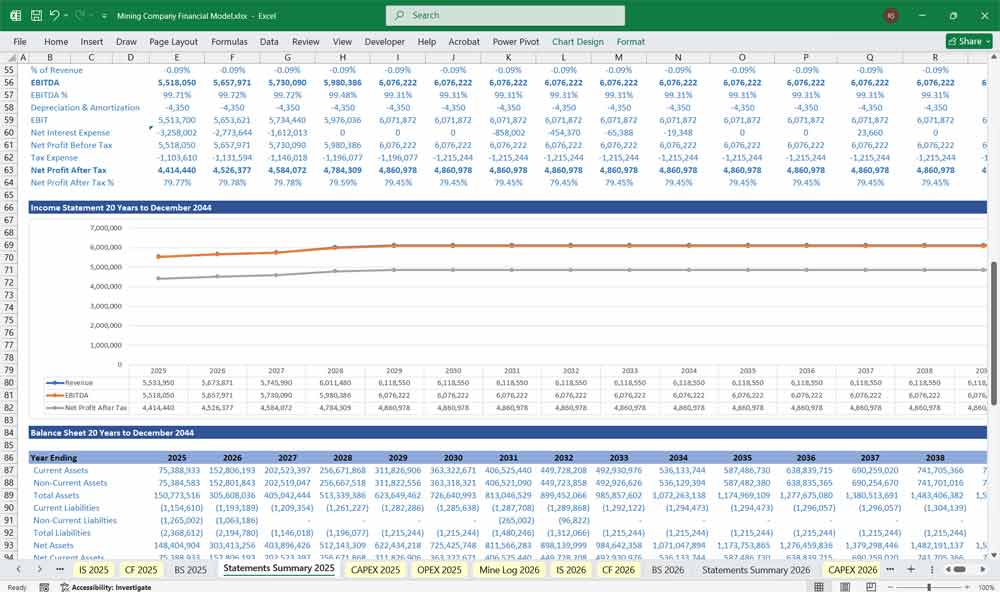
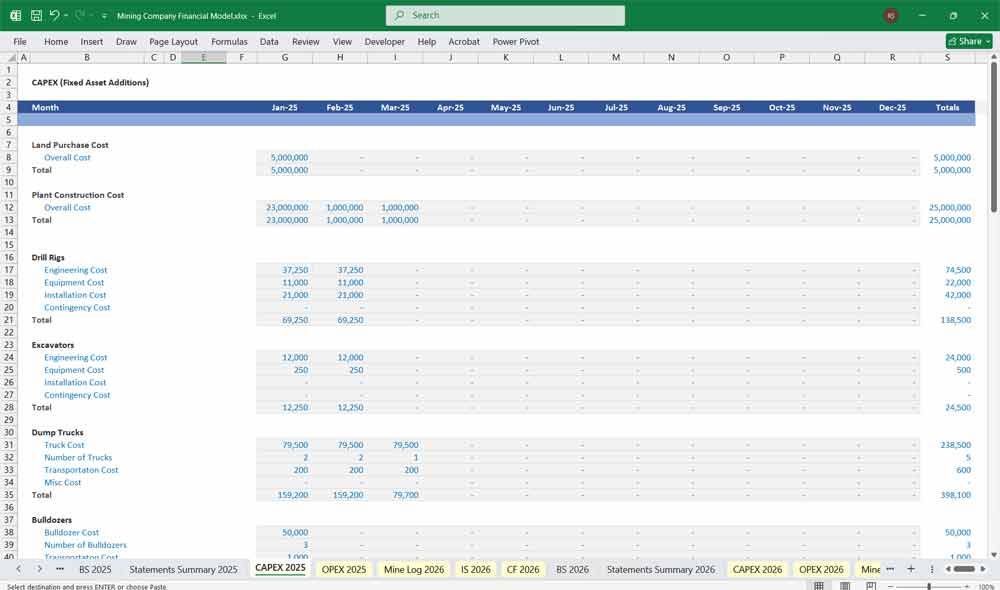
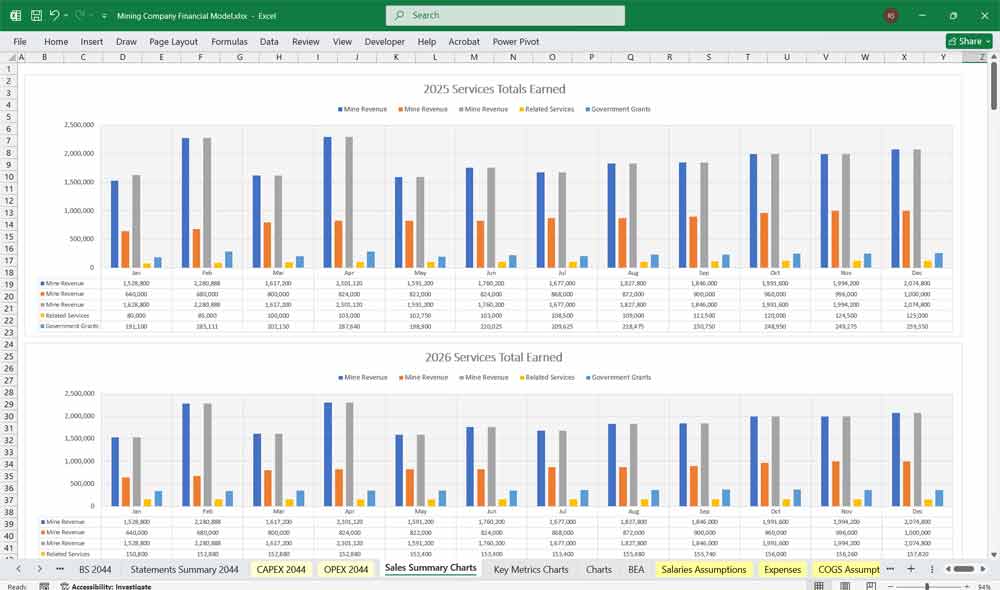
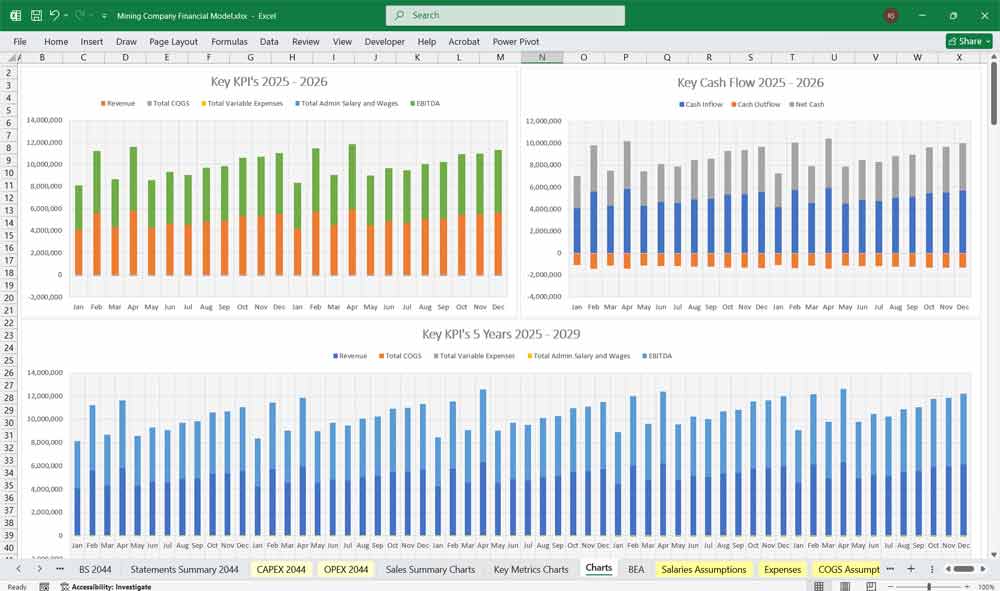
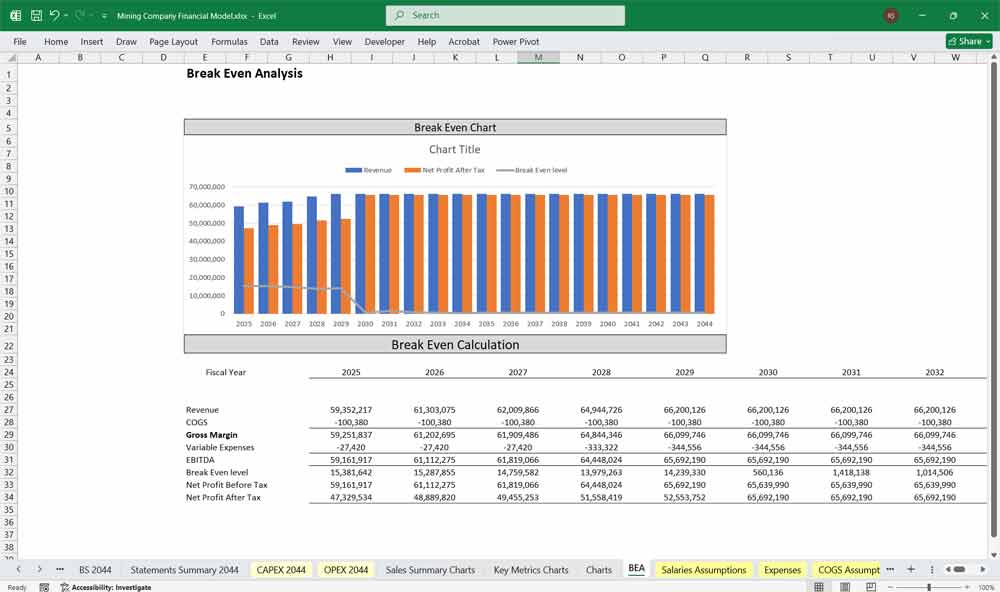
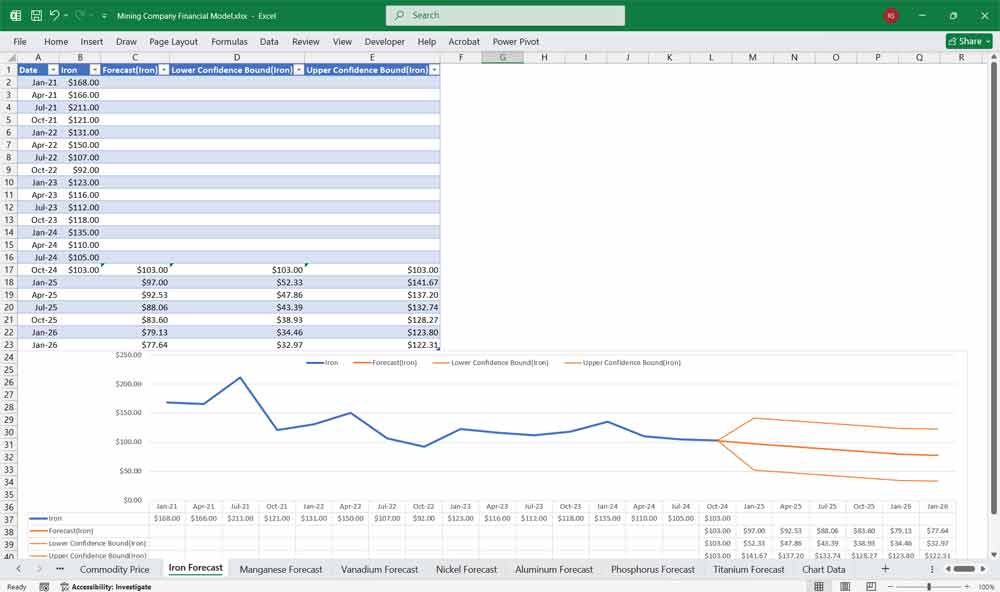
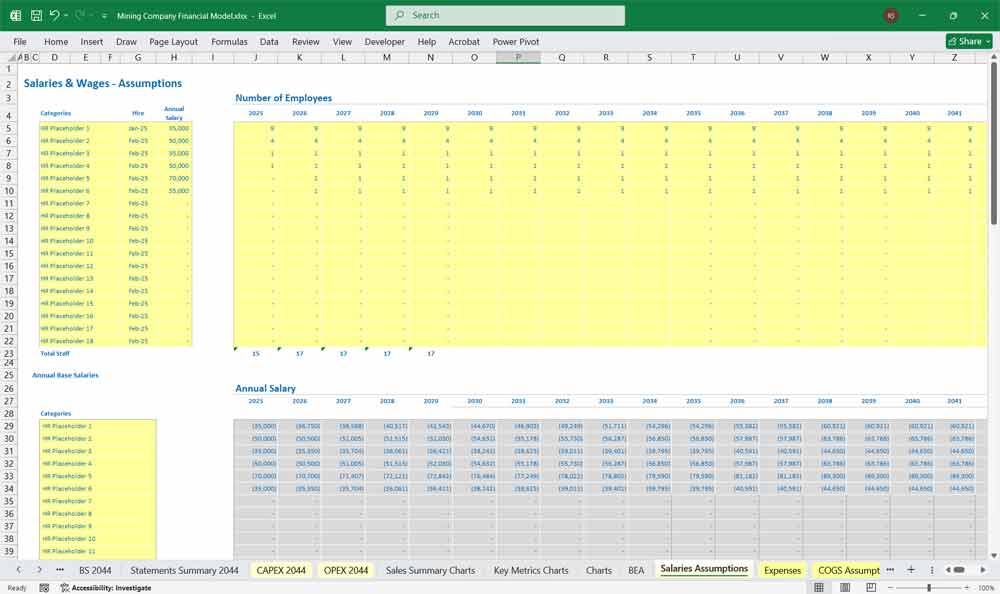
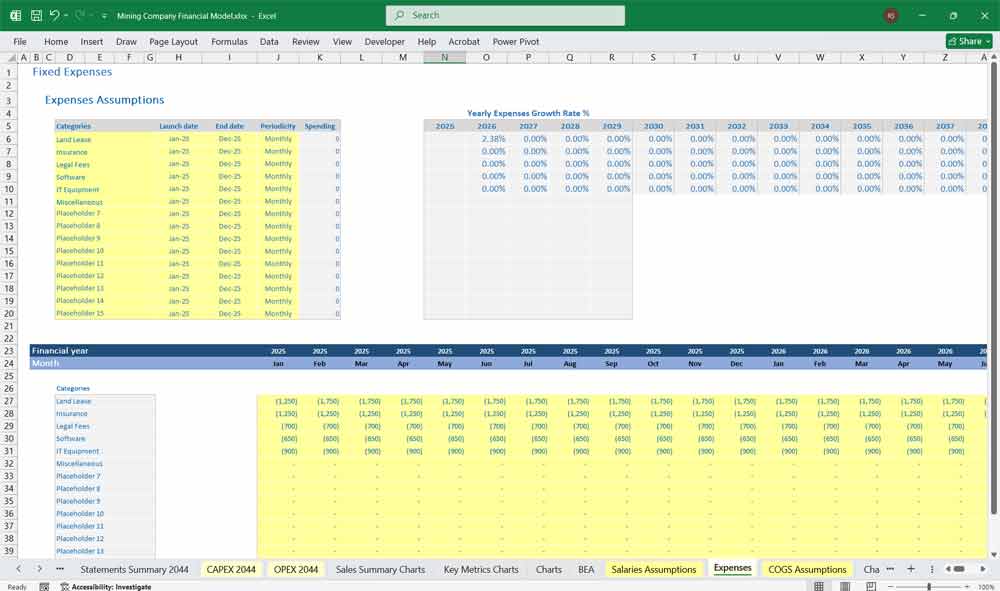
Final Notes on the Financial Model
This 20 Year Mining Company Financial Model must focus on balancing capital expenditures with steady revenue growth from diversified commodity mining. By optimizing operational costs, power efficiency, and maximizing high-margin services, this model helps to ensure sustainable profitability and cash flow stability.
Download Link On Next Page
